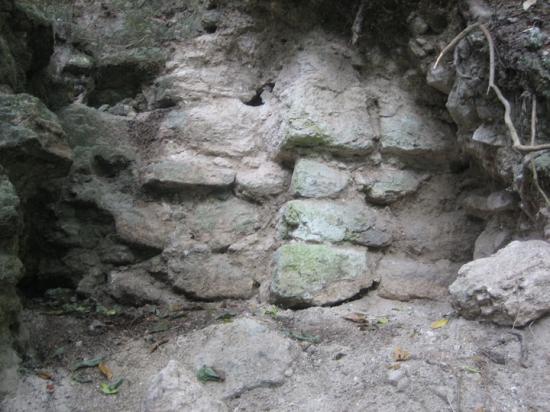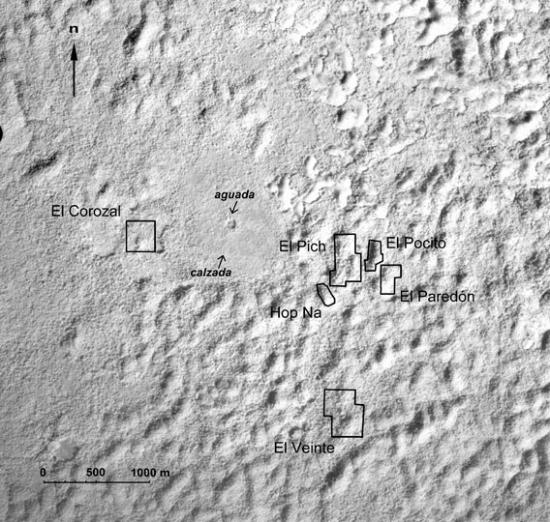Lost Maya city of Noh Kah has been mapped
Source- http://www.pasthorizonspr.com/index.php/archives/05/2014/lost-mayan-city-of-noh-kah-has-been-mapped
Photos :Noh Kah Photo Project. INAH
MAPEAN NOH KAH, UNA “GRAN CIUDAD” MAYA EN QUINTANA ROO
Source - http://www.inah.gob.mx/boletines/17-arqueologia/7180-mapean-noh-kah-una-gran-ciudad-maya-en-quintana-roo

Fachada posterior de la Estructura 1. Grupo El Paredón
Archaeologists from the National Institute of Anthropology and History (INAH) have at last confirmed that the forest in Quintana Roo hides an ancient Maya urban centre covering more than 34 hectares, containing at least six architectural groups.
A city eaten by the jungle
For people who lived in the area, El Paredón, a wall covered with creepers and roots, was clear evidence of an ancient city that had been “eaten” by the jungle.

Hileras con peldaños de escaleras. Grupo El Pich

Estructura 1, Conjunto Norte, Grupo El Corozal. Moldura en delantal típica de los basamentos asociados con el Petén guatemalteco
The researchers could give the site no other name than what the locals called the area; Noh Kah, “Big City”. For two years, specialists from the National School of Anthropology and History (ENAH) along with archaeologists from the INAH carried out detailed field collection of ceramic material and the topographic survey of the ancient metropolis.
Although it was the Paredón site that alerted the INAH to the importance of the site, archaeologist Javier Lopez Camacho, who heads these survey work, explained that this was only a small part of what he described as a, “construction boom in the city that took place more than 1,500 years ago, in the Early Classic period, between 250 and 600 AD”.
“Noh Kah belongs to a very important area that is the banks of the Hondo River, adjacent to Belize, where monumental sites were unknown, and this will throw new light on what is now known as Dzibanché sites. ” He continued.
Using aerial photography, the team of archaeologists along with a group of students, scoured the jungle for signs of archaeological features, but in the end it was necessary to follow up all the possible sites on the ground to locate and map them using a total station to create topographic plans of each architectural group.
Dynastic powerbase
Noh Kah will provide a great deal of new information about the influence of the Kaan dynasty in what is now southern Quintana Roo, which was first recognized at this site by the presence of the glyph “Snake Head”. The hieroglyphic texts suggest this was the location of his government during the 5th century AD, before moving to Calakmul in the sixth century.
The form and structure of the mounds and exposed masonry reveal two cultural stages in Noh Kah. The first one to the Early Classic, connected to the expansion of government institutions and material culture from Central Petén, in northern Guatemala today.
After the defeat of Tikal, to 562 AD, by the Calakmul state, the settlement had another period of development; “during the Late Classic, between about 600 and 800 AD, influenced by the province of Río Bec on the Yucatan Peninsula”, said the archaeologist.
Distinct architectural groups

Distribución de grupos arquitectónicos.
It still remains to define the full extent of Noh Kah. Its distribution pattern matches the pattern of settlement of other sites in southern Quintana Roo; characterized by the separation of the central area of the city into dispersed sub-cities or architectural groups, with pyramids, platforms, ceremonial areas and houses for the elite in order to exercise greater control over the population.
The architectural groups of the ancient city that have been named The Corozal, The Pich, The Paredón, The Pocito, Hop Naand The Viente, are separated by distances ranging from 0.5 to 3 kilometres. Given the ruggedness of the terrain, the builders had to construct hillside terraces, making them difficult to detect from the air which is why they remained hidden for centuries.
At the Pich, political power is revealed by the architecture, with one mound measuring 100 metres in length in addition tothree courtyards at different levels, surrounded by residential structures and a ceremonial building of greater height.

Mapa. Grupo arquitectónico El Pich
Mapping Noh Kah, looking to see how it was structured, how the architectural groups joined through roads, and infrastructure that allowed the water supply is all part of an ongoing project.
This data will help to understand the organisation of the site and its evolution from the Early Classic to Late Classic and its place in Mayan archaeology.
Noh Kah, “Big City” has increasingly become a source of revenue for nearby residents due to the implementation of theTemporary Employment Program for maintenance, and shows how the past can provide a future for local people.